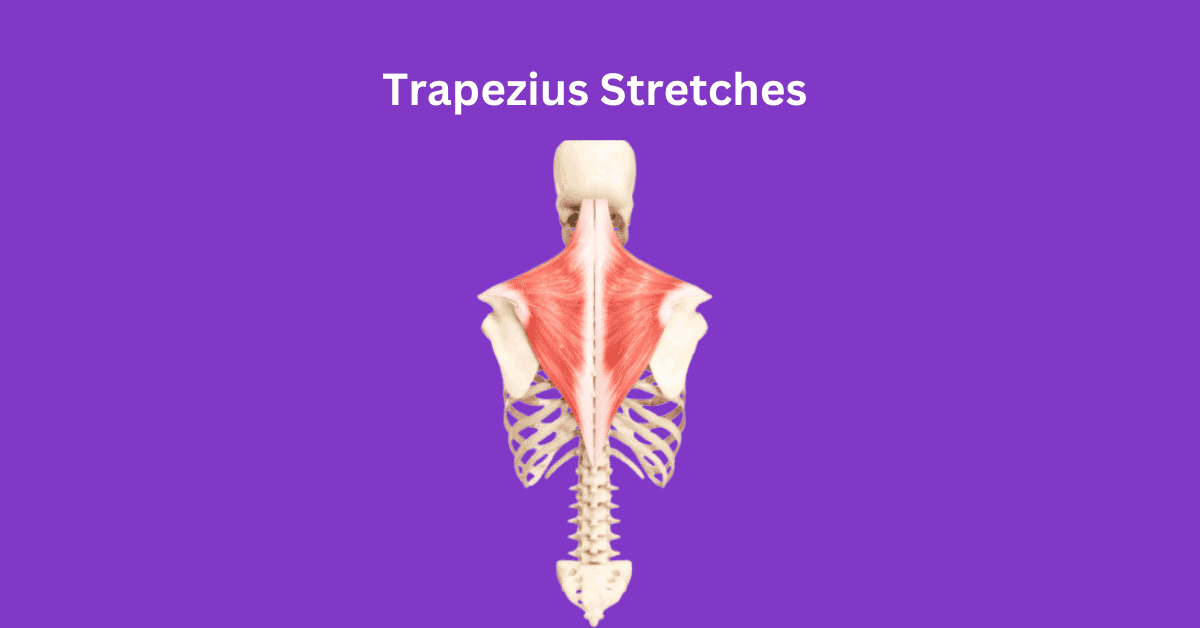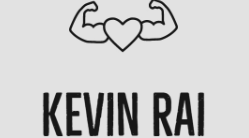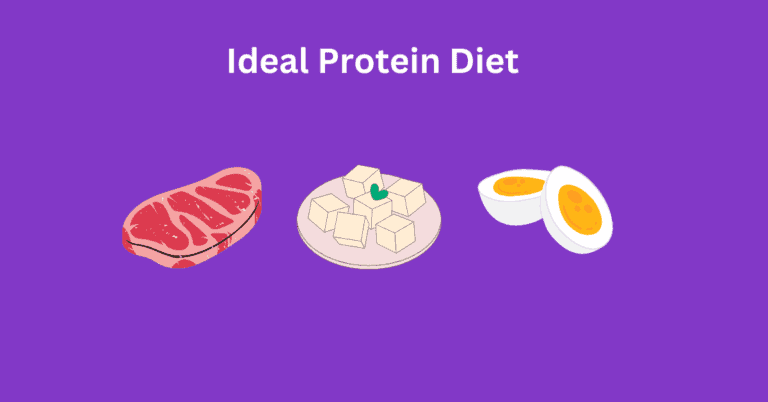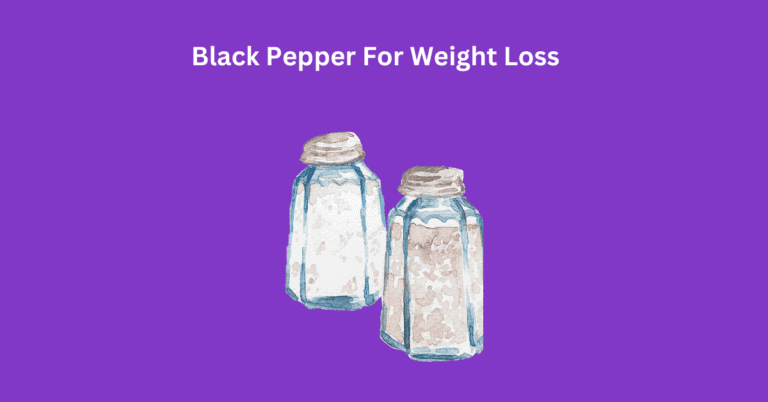6 Best Trapezius Stretches: Loosen Tight Muscles Effectively

Do you regularly feel a dull ache in your neck, shoulders, and back? If so you might be in need of trapezius stretches.
One common culprit for causing tightness in the traps, which probably most of us can relate to is sitting down in a hunched-over position for a long period of time~ this can be while watching the TV or working on the computer.
The good news is that by performing regular stretches, you’re able to slowly lengthen the muscles and reduce the symptoms of discomfort & pain.
In this article, I will go over different types of trapezius stretches, additional tips, and some common causes.
What Are The Trapezius Muscles?
The trapezius gets its name due to its trapezoidal shape and is often referred to simply as the traps. The traps are large muscles that cover a significant portion of the upper back & neck area.
They extend from the base of the skull, run along the spine, and fan out across the upper back, then to the shoulder blades.
Traps can be sectioned off into three parts: Upper, Mid, and Lower. It all works together to allow the listed functions below:
- Shoulder elevation– they help elevate the shoulders, allowing us to shrug or lift objects.
- Shoulder depression– they also depress the shoulders, which aids in movements like lowering the arms after lifting up an object.
- Scapular Retraction– traps pull the shoulder blades (scapula) toward the spine. This allows for optimal shoulder joint movement and contributes to better posture.
- Neck extension and lateral flexion– the upper fiber of the traps assists in neck movements.
Different Types Of Trapezius Stretches
In this section, I will cover stretches for all three traps individually.
With a bonus upper, mid, and lower strengthening exercise which will also aid in releasing tension from the muscles~ plus making them stronger, so they become less likely to get tight again.
Upper Trap (side neck bends)
With the upper trap attaching to the base of your neck, side neck bends are an easy & best way to stretch them out.
- Sit on a chair with an upright position.
- Push down your right arm without leaning your body.
- Using your left hand, slowly pull your head towards your shoulder as far as you can.
- Hold the position for 10-15 seconds and switch sides.
Additional tips
- Make sure not to pull your head too hard as this can strain the neck.
- Your torso should remain still throughout the stretch.
Upper Trap Stretch (small ball tension relieve)
For this, you need to get yourself a small compact ball such as a tennis ball or baseball.
Using this type of ball lets you apply pinpoint pressure on certain parts of the upper trap to increase blood circulation and help relieve tension within the muscle.
- Pin the ball on your right upper traps.
- Lean against the wall so the ball is sandwiched between the wall and your upper traps.
- Gently use your body weight to create pressure on the muscle.
- Start to move your body slightly to roll the ball along the length of the trapezius muscle.
- Focus on any tight or tender spots. When you find a knot or trigger point, hold the pressure on that spot for 15-30 seconds or until you feel the tension releasing.
- Repeat the same motion on your left upper trap.
Additional tips
- Make sure not to rush the movement, take your time to find all the tight & sore areas present in your upper traps.
- Try to target the upper traps in different angles, by turning your neck and upper body~ as this will allow you to thoroughly get rid of all the tightness.
Upper Trap (resistance bands)
A resistance band provides gradual tension as you move through the stretch, allowing you to elongate the muscle fibers further. It also helps you build strength in your upper traps.
- Sit down on a chair with good posture.
- Hold the edge of the bands with both hands.
- Tuck your elbow to your side and raise your forearm so it’s parallel to the ground.
- Simultaneously pull the bands with both arms.
- Pause for a few seconds and return back to the starting position.
Additional tips
- You can adjust the resistance by how close your hands are together~ the closer they are the harder it will be to pull the band.
- Engage your core muscle, this will help you maintain an upright position thus allowing a greater activation of the upper trap muscle.
Mid Trap (mid stretch)
This is a quick and easy method for stretching both sides of the mid trap at the same time. You have to focus on spreading your shoulder blade apart which provides a deep stretch through your upper back.
- Have your palms of the hands and forearms together.
- Push both of your elbows forward while at the same time spreading your shoulder blade apart.
- You should feel a nice stretch along mid-traps.
- Hold for 10-15 seconds and slowly get back to the starting position. Repeat for 8-10 reps.
Additional tips
- Your palms and forearms should stay in contact with each other throughout the stretch.
- If you struggle to spread your shoulder blades apart~ practice first by having your arms by the side and moving your shoulders forward, which makes spreading the shoulder blades apart easier. Familiarize yourself with this sensation and incorporate it into the stretch.
Mid Trap (door frame assisted)
If you find the process of spreading your shoulder blades a bit difficult, then this door frame-assisted stretch is a great alternative.
- Stand side by side with a door frame.
- With your right hand, reach to the left and hold the door frame.
- Take some mini-steps back until your arm is straightened out.
- Slowly twist your torso to your right, until you feel a stretch on your upper back.
- Hold the position for 15-20 seconds and switch to your left side.
Additional tips
- This stretch doesn’t necessarily need to be performed using a door frame, you can use any sturdy object that you can grab hold of comfortably.
- Avoid over-twisting your torso. Even though the stretch might feel good the more you twist, it can overstrain the muscles.
Mid trapezius (prone arm raises)
The prone arm raises is a great exercise for beginners to target the mid traps and the upper back. As you start getting stronger you can hold a pair of dumbbells for added resistance.
- Lie face down on a bench and hang your hands to the side.
- Lift your arms straight up as high as you can without feeling discomfort.
- Squeeze the shoulder blades and hold for 3 seconds.
- Slowly get back to the starting position and repeat for another 8-12 reps.
Additional tips
- Your head and chest should remain in contact with the bench when lifting your arms up.
- Don’t just let your arms drop down instead control the descent ~ this will help you get extra gains!
Low Trapezius Stretch
This motion is great for not only targeting & stretching the lower trap but also the lower back. It really helps open up the muscles, making you feel brand new after prolonged sitting.
- Get on your knees and hands.
- With your left hand reach across your body, while simultaneously twisting your torso.
- Keep going until you feel a deep stretch, then hold for 5-10 seconds.
- Repeat for 8-12 reps and switch sides.
Additional tips
- To have a solid base, have your knees below your hips and hands below your shoulders.
- The position of the lower body should not change while performing the stretch. If you feel your lower body shifting, then it means you are twisting too far.
Lower Trap (small ball tension relieve)
It can be difficult to effectively stretch out all the parts of the lower trap, due to its small size and its positioning.
Therefore one of the best methods for getting the job done is using a small compact ball, to apply a deep tissue massage.
- Position the ball on top of one side of your lower trap.
- Lean against the wall with your back.
- This is where you need to move your body around and lift up your hands at different angles, to find the tense & sore areas.
- Once you have identified an area, spend some time there, and apply different amounts of pressure if you have to.
- Keep going until your lower trap feels nice and loose.
Additional tips
- Finding the tense areas can take some time, so don’t rush the process.
- If you find yourself getting too tired from having to stand up for too long, you can perform this while lying down on the floor also.
Lower Trap (victory pose raises)
Even though the lower trap is the smallest of the three traps, it’s still important to strengthen them to prevent muscle imbalances, which can cause aches & pains.
- Attach a D-handle to a pulley cable machine.
- Adjust the height of the cable to its lowest setting.
- Hold the D-handles with both hands and take a few steps back to create tension.
- Raise your hands straight in front of you and have them parallel to the ground (this is your starting position).
- Lift your arms up and outwards to form a Y shape.
- Squeeze the shoulder blades at the top and hold for 2-3 seconds.
- Slowly lower your arm down to the starting position and repeat again for 10-12 reps.
Additional Tips
- Don’t swing your body when lifting up the weight. Try to keep your body still and focus on using your shoulders & arms to lift the weight.
- To get a full activation of your lower traps, maintain an upright posture and refrain from slouching.
What Causes Tight Trapezius Muscle?
Poor Posture
One of the most common causes of tight traps is related to poor posture.
Bad posture can lead to rounded shoulders and forward head lean. As the traps are located in the upper back and neck, they have to work extra hard to compensate for the misalignment of your spine and shoulders.
Which slowly fatigues the muscles and gives you the feeling of tightness & soreness.
Stress
It might come as a surprise but chronic stress can also lead to muscle tension.
When you are stressed, your body’s sympathetic nervous system gets activated, which leads to a fight or flight response.
As this response is our survival mechanism, it triggers muscle contraction~ which can bring up symptoms such as pain & discomfort later down the line.
Overuse
It’s important to note that while stretches and strengthening exercises help eliminate muscle tightness, on the other hand overusing them without giving enough time to recover can make the matter worse.
Overuse of the muscles can lead to microtrauma which refers to tiny tears in muscle fibers. When the body starts repairing these areas, you may face symptoms of swelling, tightness, tenderness, and discomfort.
Conclusion
If you regularly get dull pain or feel muscle tension around the neck or upper back, then performing trapezius stretches can help eliminate these symptoms.
Make sure to stretch and train all three parts of the traps, to get the most effective lengthening of the muscle and to build muscle.
A good target to aim is 2-3 days per week of stretches and 1-2 days per week of strength training.
Good luck and stay flexible.


